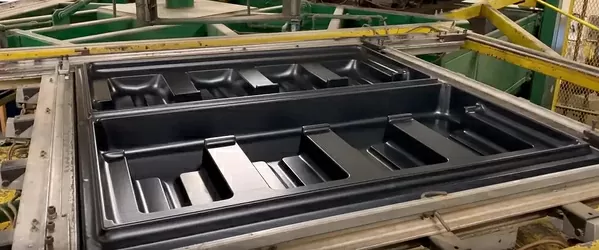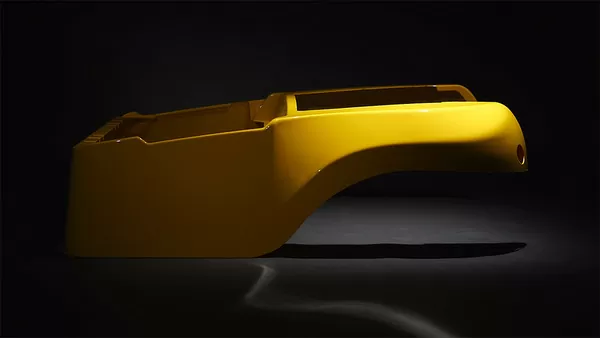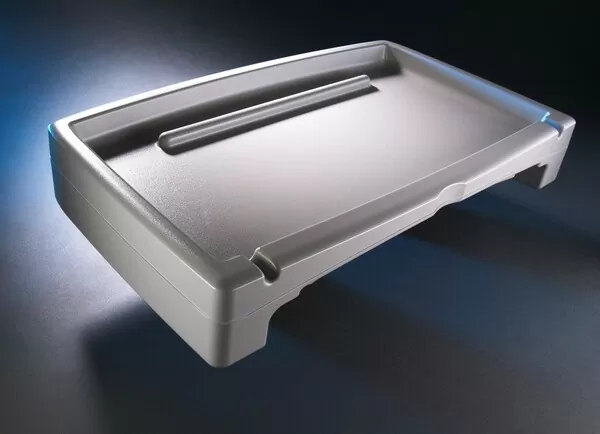Thermoforming is unmatched in terms of versatility in manufacturing. Its capacity to shape and mold both rigid and flexible thermoformed plastics has made it popular across industries. But if you really want to unlock a world of potential for big or complex parts, it's heavy-gauge thermoforming you need.
In this in-depth exploration, we shall reveal the various sectors dependent on thick gauge thermoformed components, why they favor this production technique and how thermoforming will fare as industry undergoes rapid change.

Heavy Gauge Thermoforming
To better grasp the ways in which heavy gauge thermoforming can be used, let's first make sure we know what it is. At its most basic level, this type of manufacturing involves taking a flat sheet of plastic, heating it up so that becomes soft and flexible, and then using vacuum adsorption to pull it down onto the surface of a mold.
As a result you end up with a final product-part-that often has greater thickness than those made through thin-gauge thermoforming methods.
When durability, dimensional stability, and a wide variety of shapes are necessary for parts, heavy gauge thermoforming is the best option.
If there's a need for create large plastic parts too – those with very specific measurements – then again: this is your go-to process! But who are the champions of heavy gauge thermoforming? Let’s find out!

Aerospace Industry
Precision, reliability, innovation – these are the cornerstones of the aerospace industry. And it’s exactly why heavy gauge thermoforming has found a place here; creating everything from aircraft interior components through to structural elements.
Thermoforming is a common manufacturing process for airplane interior parts such as high-impact trays and overhead bins. This technique is preferred because it creates lightweight components that can be intricately designed to blend in with the rest of the cabin features.
Thermoformed materials also play a structural role in certain elements of an aircraft - like wingtips - where their ability to offer strength without adding excess weight helps improve fuel economy.

Automotive Industry
Heavy gauge thermoforming is ideal for producing big, structural parts in automobiles that must endure the road’s demands. This manufacturing technique guarantees vehicles look good and are built to last.
Pressure forming is frequently used to make bumpers, fenders, and interior trim panels for two reasons: they need to be tough enough to withstand impacts, yet still look good (like the rest of the car).
It also helps when designers want models made – either so they can try different ideas out themselves or show potential customers exactly what’s being proposed.

Medical Equipment
In the medical equipment sector, precision and cleanliness are of utmost importance – both of which can be achieved through heavy gauge thermoforming.
This technique is commonly employed in the fabrication of casings and compartments for healthcare appliances as well as lab instruments used in analysis; qualities such as chemical resistance alongside an ability to withstand sterilization processes being vital factors when using formed plastics for these purposes.
Thermoforming provides an economical solution for manufacturing components that satisfy rigorous regulations, enable easy maintenance and cleaning protocols – all ranging from dental equipment casings through MRI machine covers.

Recreational Vehicles
Heavy gauge thermoforming is instrumental in the production of recreational vehicle manufacturers as it allows for both aesthetics and practicality.
Thermoformed components are durable enough to withstand rough outdoor conditions - a must for any motorhome, caravan or camper intended for active use!
Heavy gauge thermoforming is ideal for RV exteriors, boat hulls, and ATV body panels. Why? This technique not only produces tough components that can withstand the elements – it also enables companies to offer lots of different designs and colours, contributing to the aesthetics that consumers seek.

Appliance Industry
In the appliance sector, thermoforming is an important process because it enables items to be tough enough for diverse environments – a key requirement with products such as fridges. Vacuum forming also helps make long-lasting white goods by shaping thick components.
Thermoforming is commonly used for dishwasher parts, refrigerator linings, and washing machine boards. This technique helps make sure the components can withstand their regular use – plus, it adds thermal insulation and noise dampening to fridges, dishwashers, and washers too!

Infrastructure and Construction
Also serving the infrastructure and construction sectors, thick gauge thermoforming enables production of parts employed in critical structural and architectural applications.
Thermoforming is a popular method for creating wall panels, column covers, and station formwork because it leading supplier and manufacturers to produce components that not only meet structural requirements but are also visually attractive – important factors in ensuring overall building design works well and constructions function as intended.

Industrial Equipment
When it comes to heavy-duty industrial equipment, vacuumforming plays a crucial role. Components made from thick thermoformed materials – for example, casings, tanks and guards - are tough enough to withstand both corrosive substances and everyday wear-and-tear in an industrial setting.
These parts don’t just protect important elements inside them from harsh surroundings; they can also keep heat in (or out) effectively thermally insulating objects too if required. With thermoforming customization options like integral fixings available as well--meaning things get built-in rather than bolted-on after manufacture--extra steps like separate assembly ones may be reduced!
One more advantage of using thermoforming in these applications is its cost-efficiency. Thermoforming requires less expensive tools than other manufacturing techniques do. This matches the industrial equipment sector's requirements well: They want top-notch components that don't break the bank -- especially when produced in large quantities, as thermoforming allows for efficiently.

Consumer Goods and Retail
Heavy gauge thermoforming is used in the consumer goods and retail industries to make appealing product packaging and point-of-sale displays. For many shoppers, these items are their initial encounter with a brand - meaning good looks plus toughness really matter!
Thermoformed parts in this industry include cosmetic trays, electronics housings, and product casings. These parts do more than just protect the items they hold while they are being shipped or shown off – they also help companies with brand development and marketing efforts.

The Role of Heavy Gauge Thermoforming in Sustainability
Thermoforming with heavy gauge materials goes beyond producing big, long-lasting parts – it also helps make manufacturing more sustainable. This is because the process can employ recycled plastics, so we use resources in a circular rather than linear way and cut down on waste.
Many industries have sustainability goals, and therefore manufacturers are making more use of heavy gauge thermoforming. This enables them to produce components from materials that can be both recycled and made into something else afterwards if required. So once their time being of service has come to an end, these parts can simply be thrown away—or perhaps given a fresh purpose instead!

The Future of Thermoforming
Thermoforming has a promising future thanks to progress in material science and technology. Integration of additive manufacturing methods like 3D printing with thermoforming is increasing efficiency in creating molds and prototypes.
The possibilities for expansion in heavy gauge vacuum forming process are immense. With its distinct abilities, this technique could become crucial in shaping many sectors’ destinies – from those related to space exploration all the way through renewable power generation and beyond.

The Future of Heavy Gauge Thermoforming
The future of heavy gauge thermoformed parts looks promising due to the growing worldwide need for manufacturing solutions that are sustainable, pocket-friendly and efficient. Industries requiring strong components that also look good will still find thermoformed parts useful. Whether it is aerospace or automotive manufacturers, medical devices or consumer products – as different sectors face their own challenges, they can increasingly turn towards these types of materials.
Thermoforming's potential is endless. It can work with automation and other cutting-edge manufacturing methods. This means thermoformed materials might soon be used even more widely – making all kinds of creative products from every industry you can think of!

Conclusion
Heavy gauge thermoforming goes beyond being a mere manufacturing technique. It is indispensable for making things we use every day — whether it’s cars and trucks or gadgets vital for healthcare. As the world becomes more complexly industrialized and interconnected, heavy gauge pressure forming remains an essential technology. Its solutions are vital in many fields – from automotive to food processing; construction medical supplies!
Not only are heavy gauge thermoformed parts essential in multiple industries at present, but they are also playing a part in shaping the future of manufacturing. Their strength, design flexibility, and cost-effectiveness mean they continue to be used extensively in defense, aerospace, automotive, medical, industrial, consumer fields, custom thermoforming, interior door panels and other plastic processes – helping drive progress within them.

And as technology and materials evolve further still, it is clear these plastic components will remain key to how things are made: for they offer not just durability but bespoke solutions that can meet even the most exacting industry standards.




